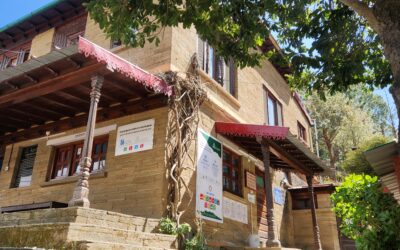When Argaben begins pinching and shaping the clay dough, she’s not doing so to put on a show. Yet, when she breathes life into the otherwise lifeless lump of clay, shaping different patterns and designs, we all watch in awe. The freehand work from memory. The fluidity of her movements is like watching a symphony. From the swift kneading of dough, the delicate rolling of small portions of the dough between her palms, turning it into cylinders of varying thickness to then getting pasted onto the moist surface of the wooden panel – it’s all so seamless. And just like that, she prepares circles that will later go on to define the boundary of her artwork.
After a moment of a break, she dips her fingers in a small paper cup placed adjacent to her. Then with her wet thumb and index finger, begins gently pinching the dough, using a sculpture technique called bas-relief (pronounced “bah-relief”), wherein the shaped patterns and designs appear to be more than halfway raised from their background. Once she’s done shaping the dough into desired patterns, she begins embedding her mud work, similar to traditional Kutchi embroideries, with aabhlas or mirrors in different shapes and sizes – round, diamond, and triangular.
This was my induction into Lippan Kaam or mud mirror work, a traditional Kutchi mural craft, more akin to a two-dimensional drawing, made using clay or mud and inlaid with mirrors. While earlier done only on mud walls of Kutchi bhungas or circular mud homes to act as insulators in extreme climatic conditions, today this craft also finds its place of pride in modern homes in the form of wall décor – think tiles and panels!
Shankar bhai Marwada, Argaben’s son, tells us that the craft came into being from locally available materials such as camel dung or wild ass dung, which were used as the main binding agent for preparing the dough. At times, millet was also used as an alternative. “But these days, instead of dung and millet, either sawdust or chalk powder is used along with white clay”, he explains.
After the dough is prepared, the walls are moistened to help the mud stick to its surface. This is followed by making borders called Kaam or Kaamtane. The dough is then rolled into cylindrical stripes of varying shapes and sizes to make patterns or motifs on the surface. It consists of okli-textures (those created by the impressions of fingers and palms) embellished with mirrors. Earlier, large mirrors were broken using stones. “They would then be arranged aesthetically to form designs and patterns”, Argaben shares.
While the authenticity of Lippan Kaam lies in a completed piece that is white-washed with clay, or in shades of neutrals (dull orange, ochre, deep browns, and olive greens); bright colors like red and green are also painted on the dried clay work.
This artwork, Argaben adds, isn’t only limited to the interior walls, but can also be found on the outer walls, partitions, doorways, window frames, pitaras, and kothis (storage cabinets), and even some floors, making it an integral part of the rural Kutchi lifestyle. The best place to firsthand witness this craft is Banni, where one can find a sea of homes adorned with this mud-relief work, we’re told.
Amongst the Rabari and Meghwal communities, the women of the house master the craft, while amongst the Mutwa community, the men make the murals in various patterns and designs. Rabari work, Argaben tells us, is characterised by thick stripes, and less care is taken to prepare the cow dung and clay mixture. The result being artwork that looks rugged and rustic.
Commonly made designs or motifs in Lippan Kaam are inspired by the rich and famous embroidery patterns, consisting of peacocks, camel, elephants, temples, and mangoes. The Muslim communities, however, only use geometric patterns as Islam does not permit the drawing of living beings as motifs. Once the walls are done, they look stunning with mirrors embedded in the mud work, much like the embroideries themselves.










0 Comments